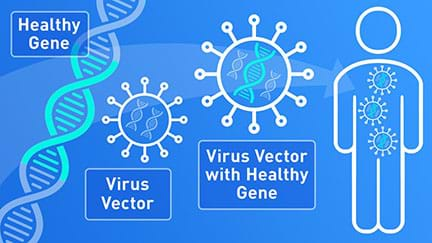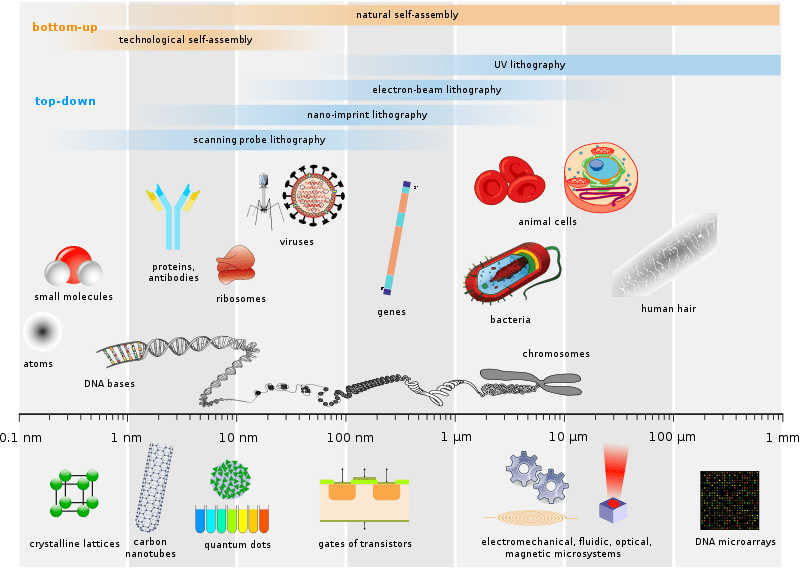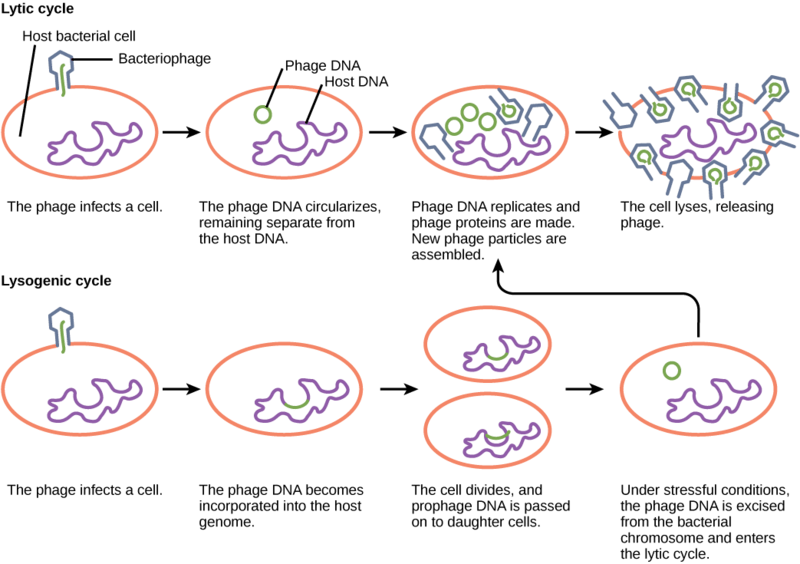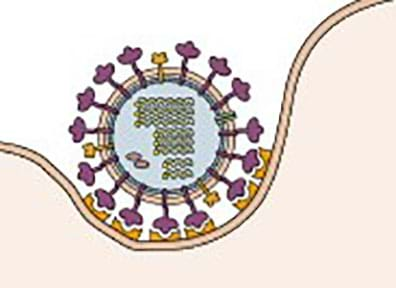Quick Look
Grade Level: 11 (10-12)
Time Required: 2 hours 15 minutes
(three 45-minute periods)
Expendable Cost/Group: US $2.00
Group Size: 3
Activity Dependency: None
Subject Areas: Biology, Life Science
NGSS Performance Expectations:

| HS-ETS1-2 |

Summary
Students become biomedical engineers and create model viruses for use in therapeutic applications, such as gene therapy. In constructing their models, students carefully plan for side effects and modify a virus that can be used to safely to deliver gene therapy. This process involves taking a “wild type” (or unmodified) virus so it can target a specific area of the body.Engineering Connection
Genetic engineering is the artificial manipulation, modification, and recombination of DNA or other nucleic acid molecules to modify an organism or population of organisms. Engineers who engage in this field are highly trained experts who use a variety of molecular tools and technologies to rearrange fragments of DNA. Their overall goal is to add or remove an organism's genetic makeup for the better, or to transfer DNA code from one species into the other.
Learning Objectives
After this activity, students should be able to:
- Understand gene therapy and its use in genetic engineering.
- Modify a virus that can be used to safely to deliver gene therapies.
Educational Standards
Each TeachEngineering lesson or activity is correlated to one or more K-12 science,
technology, engineering or math (STEM) educational standards.
All 100,000+ K-12 STEM standards covered in TeachEngineering are collected, maintained and packaged by the Achievement Standards Network (ASN),
a project of D2L (www.achievementstandards.org).
In the ASN, standards are hierarchically structured: first by source; e.g., by state; within source by type; e.g., science or mathematics;
within type by subtype, then by grade, etc.
Each TeachEngineering lesson or activity is correlated to one or more K-12 science, technology, engineering or math (STEM) educational standards.
All 100,000+ K-12 STEM standards covered in TeachEngineering are collected, maintained and packaged by the Achievement Standards Network (ASN), a project of D2L (www.achievementstandards.org).
In the ASN, standards are hierarchically structured: first by source; e.g., by state; within source by type; e.g., science or mathematics; within type by subtype, then by grade, etc.
NGSS: Next Generation Science Standards - Science
| NGSS Performance Expectation | ||
|---|---|---|
|
HS-ETS1-2. Design a solution to a complex real-world problem by breaking it down into smaller, more manageable problems that can be solved through engineering. (Grades 9 - 12) Do you agree with this alignment? |
||
| Click to view other curriculum aligned to this Performance Expectation | ||
| This activity focuses on the following Three Dimensional Learning aspects of NGSS: | ||
| Science & Engineering Practices | Disciplinary Core Ideas | Crosscutting Concepts |
| Design a solution to a complex real-world problem, based on scientific knowledge, student-generated sources of evidence, prioritized criteria, and tradeoff considerations. Alignment agreement: | Criteria may need to be broken down into simpler ones that can be approached systematically, and decisions about the priority of certain criteria over others (trade-offs) may be needed. Alignment agreement: | |
International Technology and Engineering Educators Association - Technology
-
Students will develop an understanding of the relationships among technologies and the connections between technology and other fields of study.
(Grades
K -
12)
More Details
Do you agree with this alignment?
-
Students will develop an understanding of the attributes of design.
(Grades
K -
12)
More Details
Do you agree with this alignment?
-
Students will develop an understanding of engineering design.
(Grades
K -
12)
More Details
Do you agree with this alignment?
-
Illustrate that there are multiple approaches to design.
(Grades
3 -
5)
More Details
Do you agree with this alignment?
-
Conduct research to inform intentional inventions and innovations that address specific needs and wants.
(Grades
9 -
12)
More Details
Do you agree with this alignment?
State Standards
Texas - Science
-
in all fields of science, analyze, evaluate, and critique scientific explanations by using empirical evidence, logical reasoning, and experimental and observational testing, including examining all sides of scientific evidence of those scientific explanations, so as to encourage critical thinking by the student;
(Grades
9 -
11)
More Details
Do you agree with this alignment?
-
evaluate the impact of scientific research on society and the environment;
(Grades
9 -
11)
More Details
Do you agree with this alignment?
-
evaluate models according to their limitations in representing biological objects or events; and
(Grades
9 -
11)
More Details
Do you agree with this alignment?
-
Science concepts. The student knows that cells are the basic structures of all living things with specialized parts that perform specific functions and that viruses are different from cells. The student is expected to:
(Grades
9 -
11)
More Details
Do you agree with this alignment?
Materials List
Each group needs:
- Student Handout (for each student)
- hot glue gun (with glue sticks)
To share with the entire class:
- electronic device to show videos in the Challenge PowerPoint
- Virus Info Sheets; cut these sheets up to give one virus to each group)
- craft supplies students can use to build their virus such as:
- copy paper (for drafting a plan)
- Styrofoam in various shapes such as balls, sticks, or cubes
- cotton balls and polyester pom-pom balls, in assorted colors and sizes
- pipe cleaners, in assorted colors
- toothpicks
- magnets
- Velcro
- scissors
- adhesive tape
- markers
Worksheets and Attachments
Visit [www.teachengineering.org/activities/view/rice-2368-gene-therapy-design-activity] to print or download.Pre-Req Knowledge
- Be familiar with cells and cell membranes.
Introduction/Motivation
Many medical treatments provide live-saving therapy, but have harsh side effects for patients. Think about radiation or chemotherapy in cancer patients. To reduce these side effects, engineers are currently devising different ways to deliver medical treatment. One of these delivery methods uses viruses as vectors to deliver the necessary treatment.
Viral vectors are tools commonly used to deliver genetic material into cells. This process can be performed inside a living organism (in vivo) or in cell culture (in vitro). Viruses are used because they have specialized molecular mechanisms to efficiently transport their genomes inside the cells they infect. Viral vectors are studied for use in gene therapy and the development of vaccines.
Viral vectors are tailored to specific applications, but all vectors share the following properties:
- Safety: Although viral vectors can sometimes be made from pathogenic viruses, they are modified in such a way as to minimize the risk of handling them. This usually involves the deletion of a part of the viral genome critical for viral replication. Such a virus can efficiently infect cells but, once the infection has taken place, requires a helper virus to provide the missing proteins for production in the cell.
- Low toxicity: The viral vector should have a minimal effect on the physiology of the cell it infects.
- Stability: Some viruses are genetically unstable and can rapidly rearrange their genomes. Since this instability can be harmful to the predictability and reproducibility of the work conducted using a viral vector, these viral vectors not used.
- Cell type specificity: Most viral vectors are engineered to infect as wide a range of cell types as possible. However, sometimes the opposite is preferred. The viral receptor can be modified to target the virus to a specific kind of cell.
- Identification: Viral vectors are often given certain genes that help identify which cells took up the viral genes. These genes are called markers.
Based on what you have learned, today you will take on the role of engineers! Your goal will be to “modify” a virus so that it will safely deliver gene therapy. Would you let your virus attack the whole body and create mutations that will harm the human kind, or would you make a virus that will be able to select which cells it can attach to and that will safely deliver treatment? You will start with a “wild type” virus (an unmodified virus) and modify it to target a specific area of the body.
Procedure
Background
Viruses are described as non-living infectious agents that are unable to grow or reproduce without a host cell. They are non-cellular agents made up of genetic material and proteins and can reproduce through the lysogenic or lytic cycle once attached to their host cell. Viruses are smaller than the smallest cell in the body and are measured in nanometers (see Figure 1). In fact, viruses are so small that they did not become visible until the creation of the electron microscope in 1931.

Currently, even though viruses are described as “infectious,” many are being used in the field of genetic engineering for gene therapy. But, what is gene therapy exactly? Gene therapy is an experimental technique that uses genes to treat or prevent disease. If successful, gene therapy could allow for the treatment of certain diseases by inserting a gene into a patient’s cell instead of using drugs or surgical methods. This could be done by using viruses as the vectors of the process, which will not only allow for the introduction of a new gene, but it could also help in inactivating or replacing a mutated gene. To achieve targeted gene delivery to damaged cells, peptide “locks” are introduced to the capsid of the virus. These locks block the ability of the virus to deliver its transgene to the cells, but in the presence of specific enzymes, the locks are removed by these enzymes and the virus can deliver its therapeutic payload to the diseased cells, allowing for high specificity of delivery.
The process of inserting viral DNA sequences into the cell DNA is still very risky and many scientists are currently researching how to make the process safe and more effective. One way to ensure safety and effectiveness is to research the manner of viral attachment to the host cell. As mentioned above, viruses can replicate using two different methods the lytic cycle and/or the lysogenic cycle (see Figure 2 shown below).

A specific virus used in gene therapy research is the Adeno-Associated Virus or AAV. This virus is 25 nanometers in size and belongs to the family Parvoviridae. AAV is non-pathogenic and needs a helper virus in order to replicate. To attach to a cell, this virus utilizes proteins on its outer layer which match perfectly- like a key in a lock- to the membrane of the host cell. Scientists are currently researching ways in which they can modify the proteins on the membrane of the virus in order to add “locks”. These “locks” will modify the outer structure of the virus, allowing it to only attach to the targeted cells.

Before the Activity
- Cut up the Virus Info Sheets by virus and fold in half.
With the Students
Day 1
- Slide 1: Introduce viruses to the students using the Challenge PowerPoint.
- Ask the class to share their thoughts to the questions on Slide 2 with their group.
- Distribute one Student Handout to each student.
- Give students five minutes to complete the first section of the handout.
- When students are done with the section, ask them to share their answers with the class.
- After hearing student’s responses, read the explanation of viruses on Slide 3.
- Use Slide 4 to go through the different types of viruses. Ask students what they notice about the size of the cells. (Answer: they are smaller than a human red blood cell.)
- Pose the following questions for students to think about for Slide 5: “How do viruses work? How do they attach to cells? How do they infect their host?” Allow students a few moments to think about these questions and share their thoughts.
- Play Flu Attack! How A Virus Invades Your Body from NPR on Slide 6.
- Explain what gene therapy is on Slide 7 and how it works on Slide 8. After discussing what gene therapy is, ask the students if they think gene therapy is safe. Have them discuss with their groups. Note: example to discuss would be genetically modified foods (GMOs) and if they are safe to eat.
- Discuss current uses of viruses on Slide 9. This also has a question about the issue with using viruses for gene therapy. Show Slide 10 to continue the discussion about the safety of gene therapy.
- Introduce the clip from the movie I am Legend in Slide 11 with the following questions: Why should we worry about gene therapy? Ask the students if they have ever seen the movie “I am Legend”. In this movie, a zombie apocalypse started due to the use of gene therapy for cancer.
- Start the project:
- Introduce the activity and constraints in Slide 12 (See Introduction/Motivation section).
- Give each group a folded virus and refer to Slide 13 (from the cut-up Virus Info Sheets).
- Once each group has received their virus, prompt them to start their research using the questions on Slide 13.
- Have them write their answers from their research in the Student Handout.
- What type of virus do you have?
- Is the virus pathogenic (dangerous)?
- How does the virus attach to host cells?
- Is there a specific host or cell that your virus attaches to?
Day 2
- Finish research and model planning.
- Monitor student progress. While students research, set a display of all the craft materials that the students will be able to use in this project.
- Once research has been gathered, instruct the following tasks (Tasks 1 and 2) using the Challenge PowerPoint:
Task #1 (Slide 14):
- Have students send a member of their team to the materials table and make a list of all the materials that are available.
- Let the students know that it would be a good idea to make a list so that they do not need to continuously check which materials are available.
Task #2 (Slide 15):
- Explain what the students will be creating:
- How can they make their specific virus attach to only one type of cell so it can be used for gene therapy?
- Goal: Build a virus and demonstrate how, after “genetic” modification, the virus can attach to one cell and not another.
- Instruct students to make a sketch of what they will build:
- 3D Model of “wild type” virus, or an unmodified virus. Show students Slide 15 for an explanation of a wild type virus.
- Two types of cell membranes; remind students that viruses are much smaller than cells.
- 3D model of modified virus which will be able to attach to one type of cell membrane but not the other.
- Using the list of materials made in Task #1, have students create a list of the materials they will need. Make sure you write down the exact number of each material needed.
- Important note: get students to have their plan approved before they start their build!
Day 3
- Use the Challenge PowerPoint to instruct students on Task 3:
Task #3 (Slide 16): Time to Build!
- Instruct students to send one of their group members to select materials from the materials table.
- Students will have 40 minutes to build their “wild type” virus, their modified virus and the two cell surfaces.
- Remind students to show how prior to modification the wild type virus can attach to both cells, but after modification the virus is only able to attach to one cell.
- Review final products and designs.
- At the end, have students vote for their top three viruses and turn this activity into a competition (optional).

Vocabulary/Definitions
gene: A sequence of nucleotides (in RNA or DNA) that forms the code for part of a chromosome.
gene therapy: An experimental technique that uses genes to treat or prevent disease.
genetic modification: The process of altering the genetic makeup of an organism.
lysogenic (lysogenic cycle): One of two cycles of viral reproduction.
lytic cycle: One of two cycles of viral reproduction; results in the destruction of the infected cell and its membrane.
pathogenic : An agent that causes disease.
viral vector: A tool commonly used by molecular biologists to deliver genetic material into cells.
virus: A small infectious agent that replicates only inside the living cells of an organism.
wild-type virus: The naturally occurring, non-mutated strain of a virus.
Assessment
Pre-Activity Assessment
Do Now: Have student complete section 1 of the Student Handout.
Activity Embedded Assessment
Handout: Have students finish the Student Handout. Ensure that all students are completing their own handouts, even though they are working in groups.
Post-Activity Assessment
Video/Gallery Walk: Have students present their viruses. Depending on time you can:
- Have the students create a video explaining:
- What kind of virus they are showcasing. Morphology: Parts of their virus
- Is the virus pathogenic? How do they infect cells, which cells do they usually infect (organ, humans, animals, etc.)
- How the unmodified virus attaches to both types of cell surfaces created
- Modified version of virus
- How the modified version of the virus is able to attach to one cell and not the other.
- OR you can do a “Gallery walk”, were every group chooses a speaker to showcase the project (this option is presented in Slide 17 of the Challenge PowerPoint) and they must also explain:
- What kind of virus they are showcasing. Morphology: Parts of their virus
- Is the virus pathogenic? How do they infect cells, which cells do they usually infect (organ, humans, animals, etc.)?
- How the unmodified virus attaches to both types of cell surfaces created
- Modified version of virus
- How the modified version of the virus is able to attach to one cell and not the other.
Subscribe
Get the inside scoop on all things TeachEngineering such as new site features, curriculum updates, video releases, and more by signing up for our newsletter!More Curriculum Like This

Students learn how engineers apply their understanding of DNA to manipulate specific genes to produce desired traits, and how engineers have used this practice to address current problems facing humanity. Students fill out a flow chart to list the methods to modify genes to create GMOs and example a...

Students learn about mutations to both DNA and chromosomes, and uncontrolled changes to the genetic code. They are introduced to small-scale mutations (substitutions, deletions and insertions) and large-scale mutations (deletion duplications, inversions, insertions, translocations and nondisjunction...

Students learn how viruses invade host cells and hijack their cell-reproduction mechanisms in order to make new viruses, which can in turn attack additional host cells. Students also learn how the immune system responds to viral invasions, eventually defeating the viruses—if all goes well.

Students learn about the major components and functions of the immune system and the role engineers play in keeping the body healthy through the design of medical care such as vaccinations and antibiotics. They also learn how an astronaut's immune system is suppressed during spaceflight due to stres...
Copyright
© 2020 by Regents of the University of Colorado; original © 2019 Rice UniversityContributors
Mariana Juarez SamameSupporting Program
Nanotechnology RET, Department of Chemical and Biomolecular Engineering, Department of Bioengineering, Rice UniversityAcknowledgements
This curriculum was developed in collaboration with Rice University Office of STEM Engagement, based upon work supported by the National Science Foundation under grant no. NSF EEC-1406885—The Nanotechnology Research Experience for Teachers at the Rice University School of Science and Technology in Houston, TX. Any opinions, findings and conclusions or recommendations expressed in this material are those of the authors and do not necessarily reflect the views of the National Science Foundation.
Last modified: August 5, 2020








User Comments & Tips